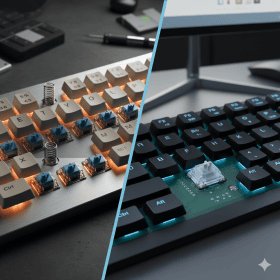When you start shopping for a new keyboard, you’ll likely see two common terms: membrane and mechanical. While these keyboards may look similar on the surface, they feel, sound, and perform very differently. Each has its own pros and cons, and each is better suited for different kinds of people and different kinds of tasks.
We’ve pulled together this guide to break down the differences in a simple way so you can quickly figure out which one best suits your needs.
What Are Membrane Keyboards?
A membrane keyboard is the ‘standard’ option for modern keyboards and the technology you’ll likely find in cheaper or productivity-focused options. It works by using several flexible layers stacked together that interact to register each keystroke.
Beneath the keycaps is a thin, flexible membrane that covers the entire keyboard surface. Below that are conductive traces – little printed wires that carry electrical signals – and under those sits a rubber dome for each key. When you press a key, the rubber dome collapses, pushing the top membrane into the conductive layer. This closes the circuit, registers the keystroke, and sends a signal to your device.
The result is a soft, quiet press that does not take much force – great for offices and classrooms where you want to avoid an orchestra of loud keyboard clacks. Membrane keyboards are also inexpensive to produce, making them a popular choice for affordable accessories and laptops. However, membrane keyboards often feel slightly mushy and less precise than mechanical keyboards.
What Are Mechanical Keyboards?
Mechanical keyboards use individual switches beneath each keycap and are actually the original technology used. While they began as the standard, they’ve come full circle and are now often associated with the top-end of keyboard options.
Unlike membrane keyboards, which rely on a single layer spanning the full board, each key on a mechanical keyboard has its own housing, spring, and electrical contacts. Not only does this often allow them to be swapped out and replaced, but it also means each key has more of an individual characteristic, which can be tailored to match your preferences.
When you press a key on a mechanical keyboard, the spring resists slightly until the switch actuates, giving clear and tactile feedback. Some switches also produce an audible click, while others are designed to stay relatively quiet. Because every key has its own switch, mechanical keyboards tend to feel more responsive, precise, and customizable than their membrane counterparts.
Comparative Analysis
We’ve covered how they work; now let’s help you quickly see which keyboard might suit you best. Here’s a side-by-side look at how membrane and mechanical keyboards compare on key factors.
Pros and Cons
Everyone’s typing style and priorities are different, but if you’re torn between which path to walk down, here’s a quick look at the main pros and cons for each keyboard type.
Choosing the Right Keyboard
Knowing the universal benefits and drawbacks to each keyboard type is a helpful starting point, but the old saying of having the right tool for the job is crucial here, too. Everyone is different, so consider if any of these use cases ring true for you.
Gamers
Mechanical keyboards are the go-to for most gamers. They offer faster response times, anti-ghosting (which prevents misclicks or errors from multiple keypresses in quick succession), and n-key rollover, which makes multiple simultaneous key presses register correctly. This combination makes a mechanical keyboard the more precise, accurate choice – especially under the pressures of a close-fought match.
You can also pick different switches that suit your style. Clicky switches are fast and offer plenty of tactile satisfaction, while linear switches deliver smooth, quiet keypresses. Of course, you can still game with membrane keyboards, but they often feel slower and less precise. They’re fine for casual gaming, but will likely hold you back in faster or more competitive games.
Office Workers and Productivity
For office environments, membrane keyboards are often the better fit, especially where quiet typing and minimal distractions are priorities. They’re unobtrusive, letting you type without disturbing colleagues or clouding your own thoughts with constant clicking and clacking.
That said, some productivity-focused mechanical keyboards feature quieter switch types, offering a more premium feel without the noise.
Writers and Developers
If you spend long hours typing, mechanical keyboards often provide a more comfortable and precise experience with plenty of longevity. The tactile feedback can improve typing accuracy over time, particularly for fast touch-typists whose fingers fly across the keys.
Be mindful when shopping for mechanical keyboards if loads of typing is your focus, as they often include more pronounced, taller key caps, which some may find irritating to use. Consider a low-profile option that maintains the benefits of the underlying switch, just with a shorter cap on top that’s easier on the hands.
Between membrane and mechanical options, you’ll find butterfly or scissor switches. These provide a super-low-profile layout similar to a membrane keyboard while still delivering some of the responsiveness of a mechanical switch. You’ll often find these in laptop keyboards, but a few standalone options exist, too, making them a great option for writers.
Budget-Conscious Buyers
If cost is your main concern, membrane keyboards are generally the most affordable option and still get the job done for everyday tasks. While mechanical keyboards come with a higher upfront cost, their durability and customization can make them a worthwhile long-term investment if you plan to use them heavily.
Customization Fans and Hobbyists
Mechanical keyboards shine here; there’s really no contest. Mechanical keyboards let you swap switches, change keycaps, and even adjust actuation force on some models. You’ll even find plenty of brands that allow you to fully custom-order your keyboard and adjust every element to your liking.
On the other hand, Membrane keyboards offer very limited customization. Most models can’t be modified beyond compatible keycaps – what you unbox is essentially what you’ll use until you replace the whole keyboard.


